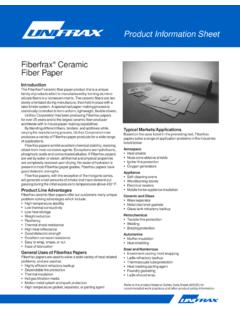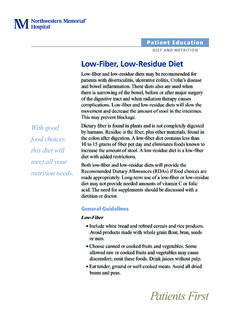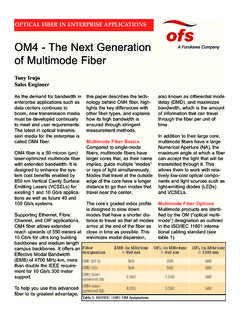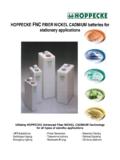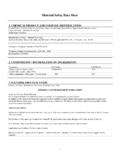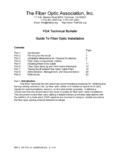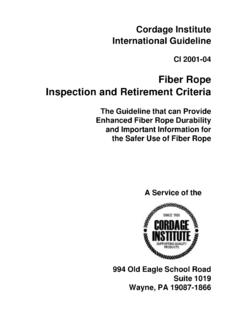Transcription of Step 1: Hydraulics – Flow - J & L Fiber
1 Fall 2004 Refining System Optimization A Simple Six- step Process The refiner is a critical piece of equipment in the paper making process. It is the only piece of equipment in the Fiber line that is designed to mechanically enhance the properties of the Fiber . Unfortunately, refiners are often neglected and inefficiently operated, negatively impacting quality and paper machine performance. What "goes on" inside the refiner has often been referred to as "Black Magic." Take the "Black Magic" out of refining by applying a simple six- step optimization process. Read on to gain the basic tools for optimizing your refining system. step 1: Hydraulics Flow hydraulic conditions are important to the refining process. Proper flow through a refiner combined with proper plate pattern design enables optimal operation and Fiber development by maintaining a stable and centered rotor, increasing probability of Fiber mat formation, maximizing Fiber strength development potential, maximizing plate life potential, and minimizing variation.
2 If your refiner hydraulic conditions are too low or too high, your refiner may produce the following symptoms: Symptoms of Low Flow Conditions Symptoms of High Flow Conditions Little or no Fiber mat between plates Inability to optimize plate design for maximumFiber channeling strength development (compromise) High pressure rise (25-50 psi) Short plate life Plate clashing Pressure drop Short plate life Motors maxed out Inefficient refining (power vs Fiber development)
3 Poor strength development Increased fines generation To correct the problem, J&L can help evaluate your system and recommend one or more of the following solutions. Each case may require a different solution set. Solutions for Low Flow Solutions for High Flow Recirculation Pump change Parallel to series Series to parallel Pattern change Additional and/or larger refiner Holdback Consistency increase Smaller refiner step 2: Consistency Refining requires getting the fibers onto the bar edge in order to be refined.
4 Optimum Fiber consistency maximizes the probability of getting the stock onto the bar edge. Proper consistency can impact refining in many of the same ways as proper hydraulic conditions. A refiner running at low consistency will cause little to no Fiber mat between plates, inefficient refining, poor Fiber development, Fiber cutting, plate clashing and short plate life. High consistency causes plate plugging and poor Fiber development. In order to maintain proper consistency, run your refiner at the recommended range of consistency based on Fiber type. If you have trouble maintaining proper consistency, call J&L for assistance. step 3: Specific Energy (HPD/T) The amount of energy transferred from the refiner's motor to the Fiber is considered "Specific Energy.
5 " Each Fiber type has an optimal Specific Energy level which will result in maximum Fiber development. Equation: SE = HPD/T = Motor Load (HP) No Load (HP) TPD Equation: SE = kWh/T = Motor Load (kW) No Load (kW) TPHr No Load is energy required to spin the rotor in a pulp slurry. To calculate No Load, the equation is No Load (HP) = ( X 10-13)( )(RPM3), where Dia is plate diameter in inches and RPM is refiner motor speed. Specific Energy Maximize Fiber Strength Strength Let J&L show you how you can maximize your Fiber development by optimizing Specific Energy. step 4: Freeness Drop / HPD/T Freeness Drop (CSF) per horsepower-days per ton is a great measure to determine the refiner(s) efficiency and if it is operating correctly.
6 An efficient refiner will maximize Fiber development with minimal energy. Delta CSF / HPD/T= CSF In CSF Out HD/T If you have low freeness drop / HPD/T, call J&L for a refiner audit. J&L will check for tough Fiber , low or high flow conditions, low consistency, improper pattern application, worn out plate, mechanical problem with refiner, improper plate installation. step 5: Refining Intensity (WS/M) How energy is applied to the pulp is called Intensity. Intensity impacts the quality of the Fiber produced. Fiber types vary greatly and each responds more efficiently to a given intensity range. Typical softwoods respond better to a higher intensity (less bar edges for a given power) as opposed to hardwoods which respond better to a lower intensity (more bar edges for a given power.)
7 The amount of energy (watts) applied across one meter of a refiner plate s bar edge and transferred to the pulp in one second is Specific Edge Load (SEL) refining intensity. Plate pattern design plays a key role in optimizing refining intensity. Intensity = WS/M = Motor Load (kW) - No Load (kW) (KM Bar Edge Crossings/Rev)(RPM)(1 min/60 sec) Typical SEL Range for Various Fiber Types If refining intensity is lower than recommended, potentially poor Fiber development will occur. All fibers require a certain intensity level to break down their walls. In addition it will cause unaffected Fiber length and inefficient freeness drop. On the other hand, if refining intensity is higher than recommended, it will result in severe Fiber cutting, plate clashing, short plate life and poor strength development.
8 Impact of Intensity on the Fiber Increase Strength & Minimize CSF Reduction If improved Fiber quality is needed in your mill, J&L can recommend the best plate pattern to optimize your refining intensity. step 6: Plate Material (Alloy) Refiner plates are consumable and need to be replaced at various time intervals. Selecting the optimum alloy for given operating conditions results in maximum refiner plate life. Selecting the wrong alloy leads to plate failures which are detrimental to refining performance. Bar breakage, plate wear and bar edge rounding can increase variation, reduce plate life, increase costs, and create inferior Fiber quality. To correct the problem and extend plate life, it is important to select the right plate material.
9 For problems of bar breakage, select a low carbon stainless steel (LCSS) alloy. It s virtually unbreakable. In cases of excessive bar wear, use a heat treated LCSS. In addition to being unbreakable it offers good wear resistance. Finally to maintain sharp bar edges which guarantee to improve Fiber quality, the answer again is a heat treated LCSS. A heat treated LCSS alloy will re-sharpen during operation. Call your J&L Representative. Together with J&L's Technical Support, he can assist you in applying this Six- step Process to ensure optimal performance of your refining system. J&L Fiber Services, Inc. 809 Philip Drive Waukesha, Wisconsin 53186 Phone: 262-544-1890 Fax: 262-547-8166 2004 J&L Fiber Services, Inc.


